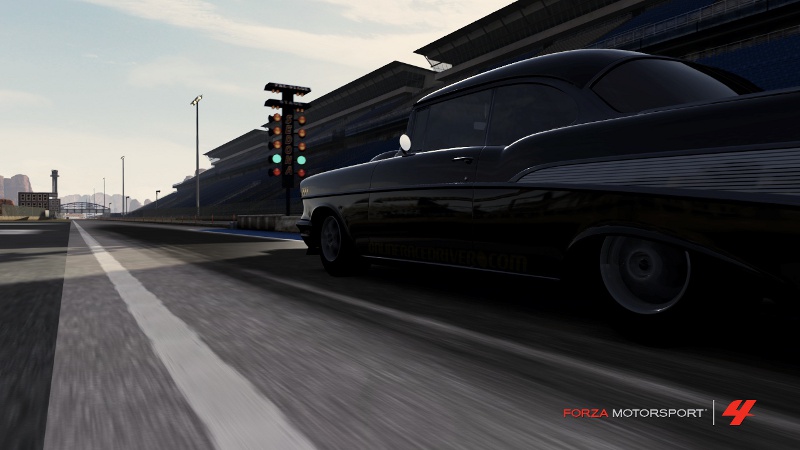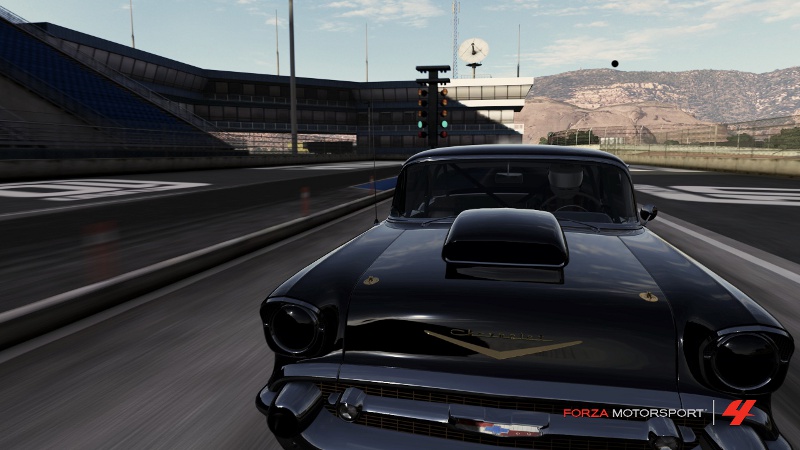Last updated on January 12th, 2021 at 02:40 pm
Hello onlineracedriver drag racing fans!
Before the shouting begins let me ward off a few well intended people with the caveat that drag racing is an absolute sport, with a wide ranging set of variables effecting its absolute-ness. In other words, don’t hold my feet to the flames if your favorite car is shown to be under performing in this comparison test compared to what you know. With that said let me also assure the reading audience that every effort was made to get the most out of the 20 selected cars.Forza4 drag racing can be faulted for many things, but since doing so would be too easy and way too obvious, the focus of this article will be on the relative performance between the real cars, and their FM4 counterparts.
Even so, it has to be said that the most glaring fault of Forza drag racing is the absence of a working starting tree. As anyone in drag racing will tell you, “he who cuts the best light usually wins”, –but in Forza4 there is no light to cut. There is a static tree and an automatic launch system, but there is no way to jump the start, or do a perfect .000 launch on your own. In fact, every launch is perfect as dictated by the game software. That is, you can start too slowly, or you can leave the line perfectly on time, as the computer allows you to do. The car will not move until the computer does a count down. There are no reaction times like in real drag racing either, (a critical aspect of the sport.) It’s sad really, because it takes away from the sport the very essence of what drag racing is all about, and that is, the start of the race.
Forza vs Real World on the Drag Strip
Since we can’t dive into simulated drag racing as a competitive sport in Forza (even though many have suspended their disbelief and do drag racing anyway), we can still talk about how well the cars perform and what might be the best way to run a good time. The 20 real cars I selected were cars that have known 1/4 mile times from various major publications over the years. These officially tested times are within plus or minus 0.3 tenths of their absolute best times. As tested they were completely stock, just as the Forza4 cars were. The only exceptions were the two production factory race cars of the bunch, the 1968 Hemi Dart, and the 1964 Ford Thunderbolt. These two cars were fitted with drag racing slicks, since the real cars were also.
Looking at the list of cars, there are a couple of things you’ll notice right away. One is that the speeds are a lot closer to the real cars than the times. Speed is an indicator of horse power, whereas time is an indicator of traction. It seems that the boys at “Turn10” have done a remarkable job getting the simulated horsepower and torque correct. They should be given a real pat on the back for this alone, because it is nearly perfect. On the other hand, the track surface is woefully off the mark in terms of absolute traction. It’s so bad that it can’t be easily compared to any known asphalt surface. The best analogy would have to be that of a partially wet track, it’s just that slippery. This is surprising since T10 knew of this problem in FM3 and even corrected the friction ratio for the strip in that game.
Of all the drag strips in FM4, Sedona was proven to be slightly more sticky than the others, so I used it over the rest for best results. For those that have never been to a real drag strip, you have to understand that “sticky” doesn’t quite describe how much grip there is. Stand long enough in one place on a hot summer day, on the track, and your shoes will be stuck to the tarmac like glue. On a real track, it’s not the track that lacks adhesion, it’s the stock tires. Forza tires seem to be relatively fine and in keeping with known performance characteristics, but the tracks are no where close to reality.
Getting the perfect drag racing start
So what do you do to get a good launch on a track with about the same grip as a greasy McDonald’s drive-thru on a rainy day? Hold her to the floor of course! Well, not exactly lol. I’ve found that the best result is to hold it wide open during the computer count down, and then at just the right moment when the computer goes to 1sec and is about to let you go, you let almost completely off the throttle, allowing the engine to, “fall on its face” down around idle, and then ever so carefully feed the throttle back in as you try to limit wheel spin. The other method that works about as well, but is harder to master is to hold the throttle just above idle, and when the computer releases the car, slowly give out steady amounts of throttle avoiding wheel spin. Either way will net you about the same times, but neither way is what real drag racers do! In real drag racing you will either load the engine up with the brake while applying throttle, or you will sit at idle and then mash the throttle to the floor when you see that last amber light come on.
The other thing you can see on the list below is that the real cars are about one second quicker on average in most cases, even when they have a similar trap speed. This is the proof that tells you the Forza cars are suffering in the traction department, but I don’t blame the tires nearly as much as the track. Only one of the Forza cars was able to beat its real-life counterpart, and that was the 1966 Chevy Nova SS. It was a good half second quicker and 7mph faster falling well outside of the variable margins for this car. Of the 20 cars tested the Enzo Ferrari came the closest to replicating the real cars performance. The 1968 Hemi Dart was the worst simulated car when compared to the real thing at more than 2sec slower, and almost 20mph down on the top end.
As a group, the Forza cars were significantly slower but consistently comparable in a progressive way just like the real cars. In fact, if you ignore the times altogether you have a near match from fastest to slowest when comparing the two groups. The 10th place 2002 Camaro SS was about the 10th place car in the same group on the Forza side for example.
Each car was given about 6 passes to get a good run out of them. Doesn’t mean you couldn’t do better, you can, but only by a tenth or two which is within the acceptable range. Even the real cars will vary about this much depending on the car, the track conditions, the weather, and the driver.
My conclusion is that T10 has the cars very nearly perfect in the ultimate measure of performance known as drag racing. What they didn’t get right was the virtual track traction, it’s so bad that you wonder if anyone at T10 has ever been to a real drag strip before. Oh, and the lack of a fully functioning tree is unforgiveable. But hey, there’s always Forza5 and the hope they will finally get it right then.
Full throttle,
AAR GTDon
| Real | Forza | |||||||
| Car | Engine | Time | Mph | Time | Mph | |||
| 1 | 1968 Dodge Dart Hemi w/slicks | 426cid | 10.30 | 135 | 12.481 | 116 | ||
| 2 | 2002 Enzo Ferrari | 366cid | 11.00 | 136 | 11.331 | 137 | ||
| 3 | 2005 Ford GT | 329cid | 11.20 | 131.2 | 12.231 | 123 | ||
| 4 | 1964 Ford Thunderbolt w/slicks | 427cid | 11.76 | 122.7 | 12.214 | 118 | ||
| 5 | 1967 Corvette Stingray | 427cid | 12.072 | 117.67 | 13.465 | 110 | ||
| 6 | 1965 Shelby Cobra S/C | 427cid | 12.70 | 112.7 | 12.731 | 122 | ||
| 7 | 1971 Plymouth Hemi Cuda | 426cid | 13.25 | 109 | 14.480 | 106 | ||
| 8 | 1970 El Camino | 454cid | 13.44 | 108.17 | 14.765 | 106 | ||
| 9 | 1970 Dodge Super Bee | 426cid | 13.49 | 105 | 14.331 | 111 | ||
| 10 | 2002 Camaro SS | 350cid | 13.55 | 105 | 14.397 | 104 | ||
| 11 | 1969 Pontiac GTO Judge | 400cid | 13.70 | 103.6 | 14.747 | 102 | ||
| 12 | 1970 Chevelle SS | 454cid | 13.70 | 103 | 14.714 | 106 | ||
| 13 | 1970 Buick GSX | 455cid | 13.80 | 101 | 14.947 | 101 | ||
| 14 | 1971 Mustang Mach 1 | 427cid | 13.90 | 102 | 14.780 | 105 | ||
| 15 | 1956 Jaguar D-Type | 207cid | 13.90 | 100 | 14.964 | 107 | ||
| 16 | 1965 Pontiac GTO | 389cid | 13.940 | 99.81 | 14.847 | 103 | ||
| 17 | 1969 Hurst/Olds 442 | 455cid | 14.03 | 101 | 14.931 | 101 | ||
| 18 | 1968 Firebird | 402cid | 14.070 | 100.81 | 14.780 | 103 | ||
| 19 | 1969 Camaro SS | 396cid | 14.70 | 98.7 | 14.847 | 102 | ||
| 20 | 1966 Chevy Nova SS | 327cid | 15.10 | 95 | 14.662 | 102 |


i remember having a discussion to you about the lack of a professional or even amateur tree in the lobby’s and how cool it would be to have one that dropped the green light randomly rather than a 3-2-1 go that we unfortunately are stuck with. But this was a good read, good work organizing all this information too.
This is a very interesting article. I think there should be system where you could jump the start. I am also pleased that there are more drag strips in the game (new ones include Top Gear, Hockenheimring). Thanks also for the starting advice; that could also help in standing start races.